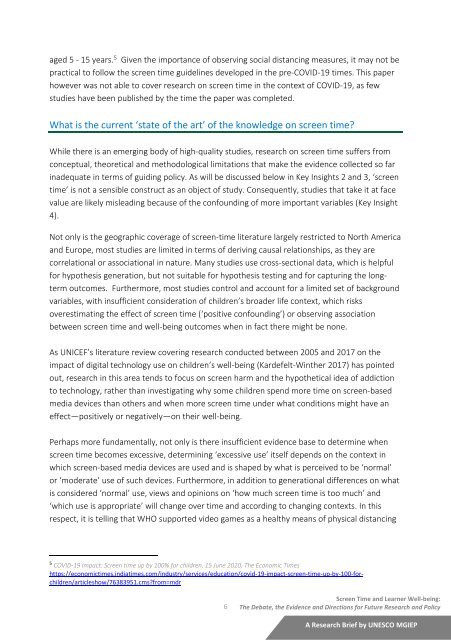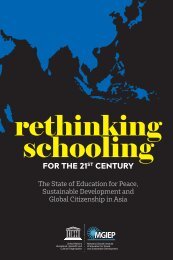Screen Time and Learner Well-being
The Debate, the Evidence and Directions for Future
The Debate, the Evidence and Directions for Future
Create successful ePaper yourself
Turn your PDF publications into a flip-book with our unique Google optimized e-Paper software.
aged 5 - 15 years. 5 Given the importance of observing social distancing measures, it may not be<br />
practical to follow the screen time guidelines developed in the pre-COVID-19 times. This paper<br />
however was not able to cover research on screen time in the context of COVID-19, as few<br />
studies have been published by the time the paper was completed.<br />
What is the current ‘state of the art’ of the knowledge on screen time?<br />
While there is an emerging body of high-quality studies, research on screen time suffers from<br />
conceptual, theoretical <strong>and</strong> methodological limitations that make the evidence collected so far<br />
inadequate in terms of guiding policy. As will be discussed below in Key Insights 2 <strong>and</strong> 3, ‘screen<br />
time’ is not a sensible construct as an object of study. Consequently, studies that take it at face<br />
value are likely misleading because of the confounding of more important variables (Key Insight<br />
4).<br />
Not only is the geographic coverage of screen-time literature largely restricted to North America<br />
<strong>and</strong> Europe, most studies are limited in terms of deriving causal relationships, as they are<br />
correlational or associational in nature. Many studies use cross-sectional data, which is helpful<br />
for hypothesis generation, but not suitable for hypothesis testing <strong>and</strong> for capturing the longterm<br />
outcomes. Furthermore, most studies control <strong>and</strong> account for a limited set of background<br />
variables, with insufficient consideration of children’s broader life context, which risks<br />
overestimating the effect of screen time (‘positive confounding’) or observing association<br />
between screen time <strong>and</strong> well-<strong>being</strong> outcomes when in fact there might be none.<br />
As UNICEF’s literature review covering research conducted between 2005 <strong>and</strong> 2017 on the<br />
impact of digital technology use on children’s well-<strong>being</strong> (Kardefelt-Winther 2017) has pointed<br />
out, research in this area tends to focus on screen harm <strong>and</strong> the hypothetical idea of addiction<br />
to technology, rather than investigating why some children spend more time on screen-based<br />
media devices than others <strong>and</strong> when more screen time under what conditions might have an<br />
effect—positively or negatively—on their well-<strong>being</strong>.<br />
Perhaps more fundamentally, not only is there insufficient evidence base to determine when<br />
screen time becomes excessive, determining ‘excessive use’ itself depends on the context in<br />
which screen-based media devices are used <strong>and</strong> is shaped by what is perceived to be ‘normal’<br />
or ‘moderate’ use of such devices. Furthermore, in addition to generational differences on what<br />
is considered ‘normal’ use, views <strong>and</strong> opinions on ‘how much screen time is too much’ <strong>and</strong><br />
‘which use is appropriate’ will change over time <strong>and</strong> according to changing contexts. In this<br />
respect, it is telling that WHO supported video games as a healthy means of physical distancing<br />
5<br />
COVID-19 Impact: <strong>Screen</strong> time up by 100% for children, 15 June 2020, The Economic <strong>Time</strong>s<br />
https://economictimes.indiatimes.com/industry/services/education/covid-19-impact-screen-time-up-by-100-forchildren/articleshow/76383951.cms?from=mdr<br />
6<br />
<strong>Screen</strong> <strong>Time</strong> <strong>and</strong> <strong>Learner</strong> <strong>Well</strong>-<strong>being</strong>:<br />
The Debate, the Evidence <strong>and</strong> Directions for Future Research <strong>and</strong> Policy<br />
A Research Brief by UNESCO MGIEP

















